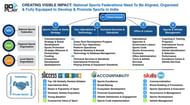Indians at the Commonwealth Games 2018 have clearly demonstrated that there is no dearth of talent in the country. If one has the hunger and the passion to excel coupled with focus, hard work and perseverance, no goal is unattainable. India's athletes, despite systemic limitations and structural flaws, have managed to deliver handsome results. Hats off to them.
Hopefully, this success will finally convince this nation of our potential in sports and our ability to deliver big results in international events. Indians have followed CWG2018 like never before, cheering & rooting for India's heroes and the outpouring of love across media platforms is just phenomenal.
Most importantly, I hope that these results encourage the gamekeepers of sports in India to drastically improve the management, infrastructure, services and sports ecosystem to enable our sportsmen to dream big and deliver even bigger results.
For that to happen, India's gamekeepers at all levels (central & state ministries & national sports federations) need to change the ways that sports are governed, managed and executed at all levels. The system and attitude towards sports and athletes have to be encouraging and enabling rather than disillusioning, to say the least.
As India begins its preparation for the Tokyo Olympics 2020 & beyond, it is critical that every effort is made to enable high-performance athletes. For now, some sporadic efforts have begun and other opportunistic remedies have been initiated. I think we are all thankful that an ex-Olympian, Col Rajyavardhan Rathore is today heading the Sports Ministry and spearheading this change. However, much more needs to be done and time is running out.
In order to improve, it is critical that India looks at all three equally important components of change - (1) Structural & Systemic Construct, (2) Process & Standards & Protocol and (3) Attitude & Behavioral Orientation.
For India to systematically identify, select, nurture and develop talent and institutionalize the process, there is an urgent need for a holistic & seamlessly integrated sports management mandate & structural overhaul, as highlighted below.
At The Central Government (Ministry of Youth Affairs & Sports) Level,
(ONE): SPORTS GOVERNANCE: A framework that addresses responsible decision making, accountability, ethical standards, systems and process by which the entity and sport are managed, transparency, risk, integrity, financial controls & adhere to legal & regulatory obligations. Key focus: (1) Strategic vision, goals and direction, (2) Performance monitoring, (3) Safeguard stakeholder interests, (4) Power balance between federation and athlete, (5) Private sector participation
(TWO): SPORTS CODE: A set of guidelines loosely defined as a constitution that establishes a set of rules and protocols that need to be adhered to by all bodies involved in the governance & implementation of sports. This Sports Code will establish the criteria, obligations and standards that need to be complied with, in order to (1) Retain official status and recognition, (2) Represent and field Indian teams & (3) Avail funding & grants.
(THREE): NATIONAL SPORTS DEVELOPMENT FUND: A central pool to raise, allocate, prioritize & distribute funds for sports awareness and development. This will include funds from both the public and private sector. And may include centralized thematic fund collection efforts under CSR & sports.
(FOUR): PROGRAMS: Central government programs such as Khelo India to promote multiple sports simultaneously or individual sports through a single sport platform-based approach. This would include Olympic and non-Olympic sports. Simultaneously, Khelo India has to widen the net to include the U-17 age groups all the way down to 6 - 8-year-olds.
(FIVE): SPORTS ASSETS: All central and state government sports assets, including arenas, stadiums, performance & training centers. Also include leverageable assets such as lakes, arenas, playing fields, stadiums, competitive platforms, national circuits, etc.
(SIX): SUPPORT SERVICES: All central and state government services that include sports advisory, game refereeing and coaching, technology platforms, nutrition, fitness, sports science, talent identification & scouting, broadcasting and digital media.
(SEVEN): SPORTS PROMOTION: Central government programs of national importance for sports education, awareness building, performance excellence, broad-basing sports & promotional efforts needed as a national priority. Efforts to create national icons/heroes/role models will be an integral part of the effort.
(EIGHT): WORLD ATHLETE: This category will include athletes across age groups that become national assets by virtue of their performance and potential in international competitions.
In order to deliver this mandate, two critical components include - (1) Credible, capable and committed manpower to deliver results & (2) Corporate involvement in sports development
At the National Sports Federation Level
The 5 point agenda for Sports Federations should include - (1) Sports vision, game strategy & plan, (2) Grassroots development, (3) Operations & technology, (4) Commercialization & sports promotion plan and (5) Office & liaison. A further, next level break down of what this will entail is provided in the diagram below:

Grass root implementation of programs, increasing participation, awareness building promotional efforts & strengthening the sports ecosystem have to be initiated by the Federations in partnership with private players to support the commercialization of sports in the long term. The Federations can no longer afford to believe that launching a league will automatically result in developing the sport. Much more needs to be done, for which a holistic game development program needs to be institutionalized.
In a country where close to 40% of our population is under the age of 20 years, sports can effectively be used to inculcate life skills and creatively channelize youthful energies to creative pursuits. If we have to build a fit, healthy and vibrant India of the future, this cannot be ignored.
